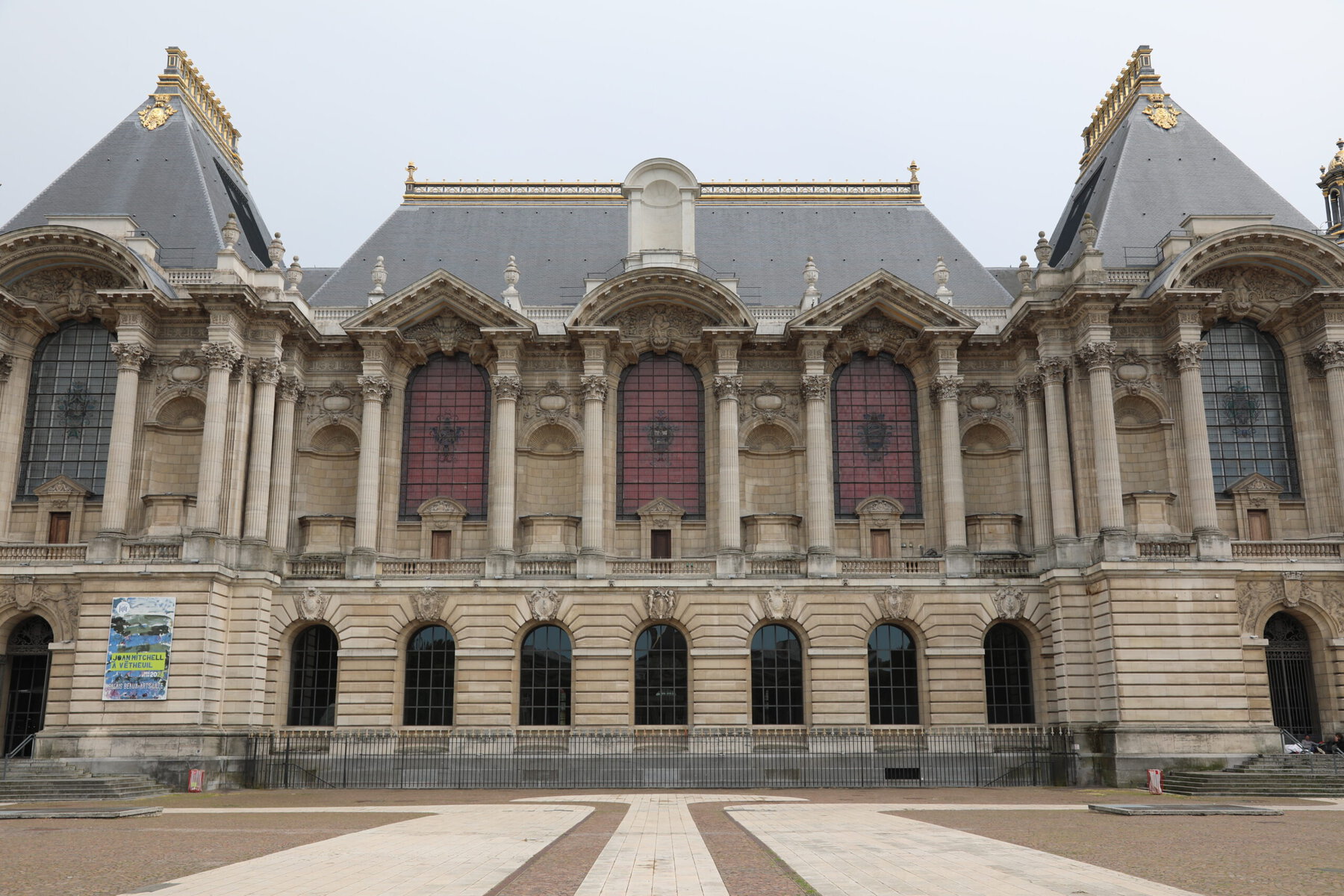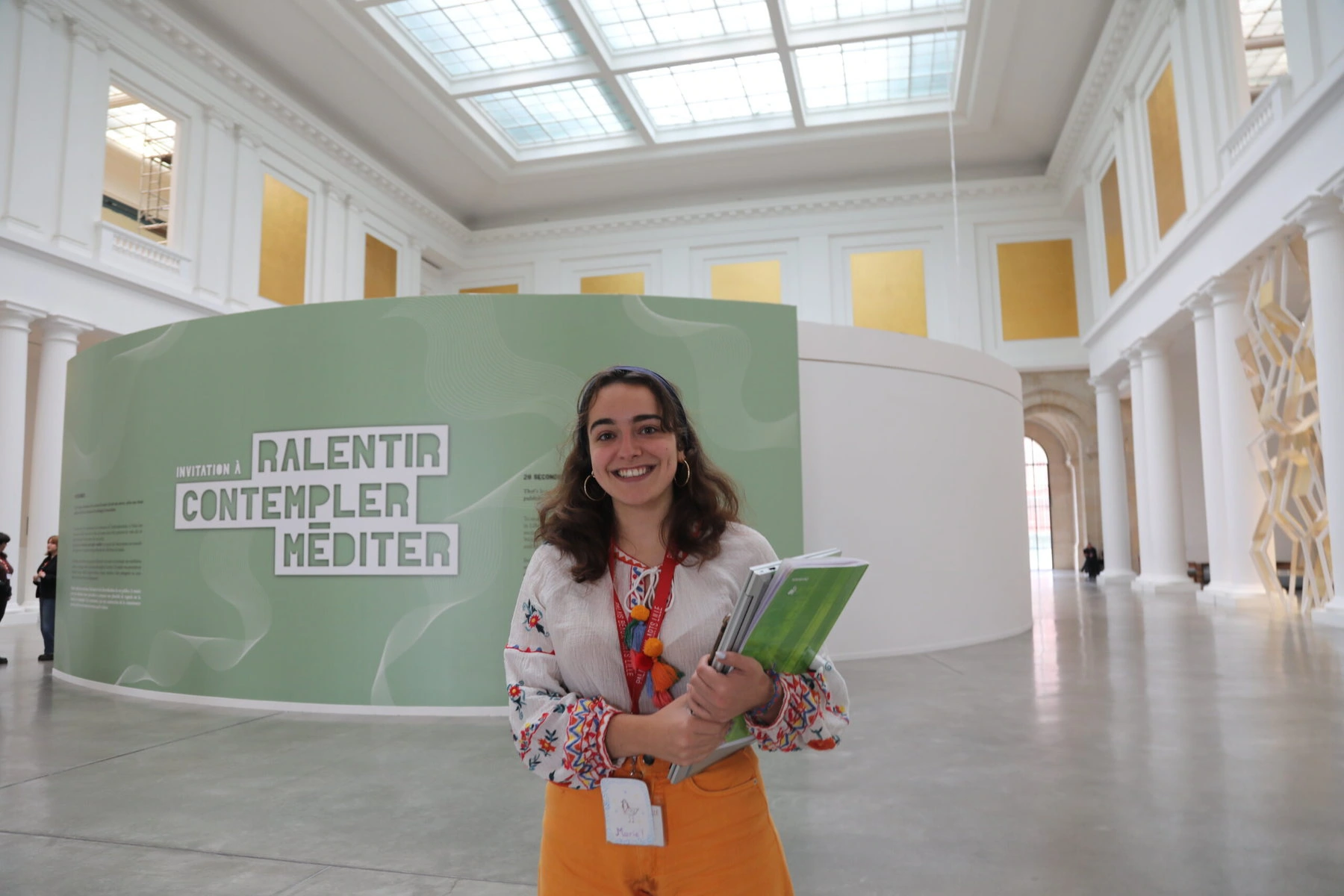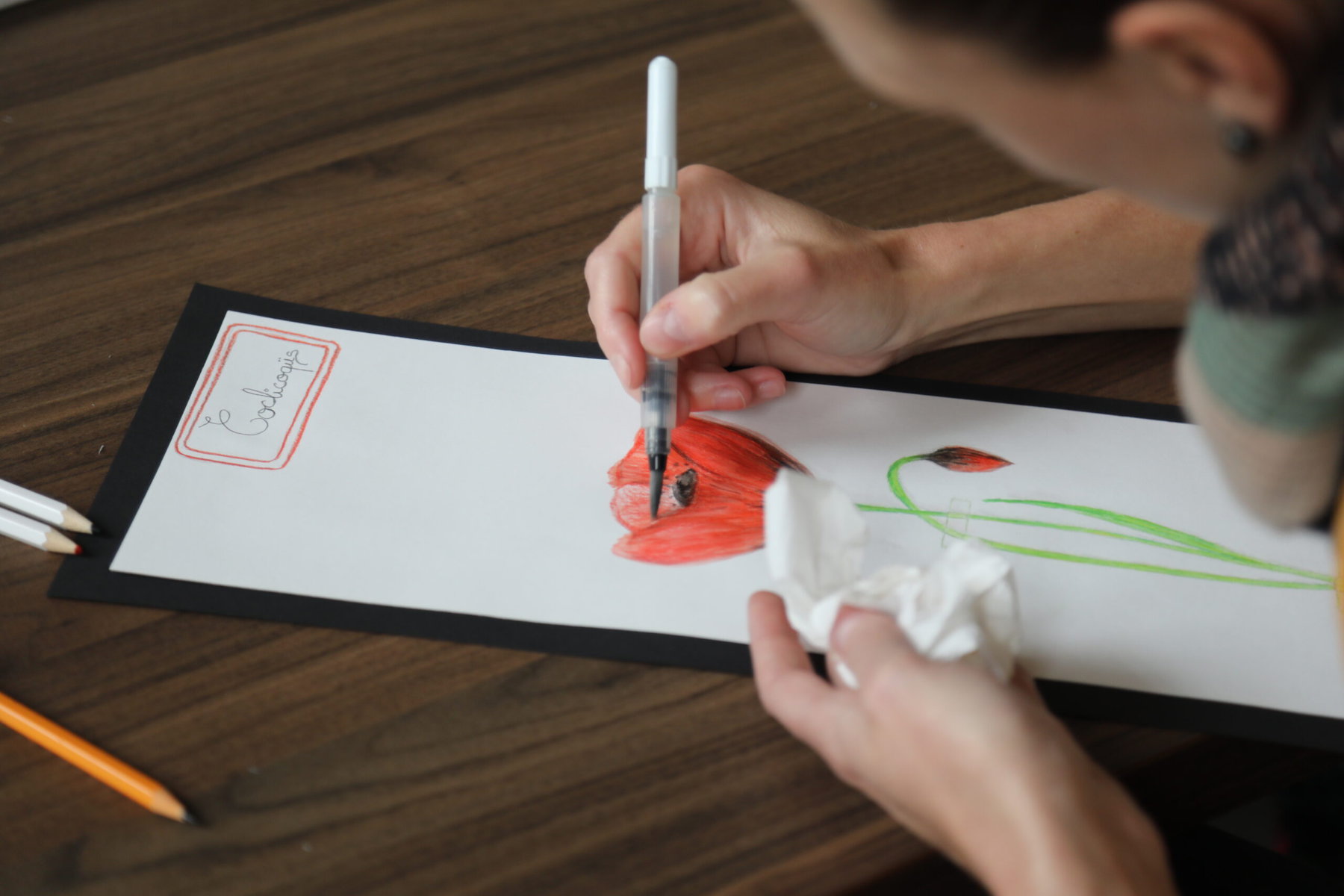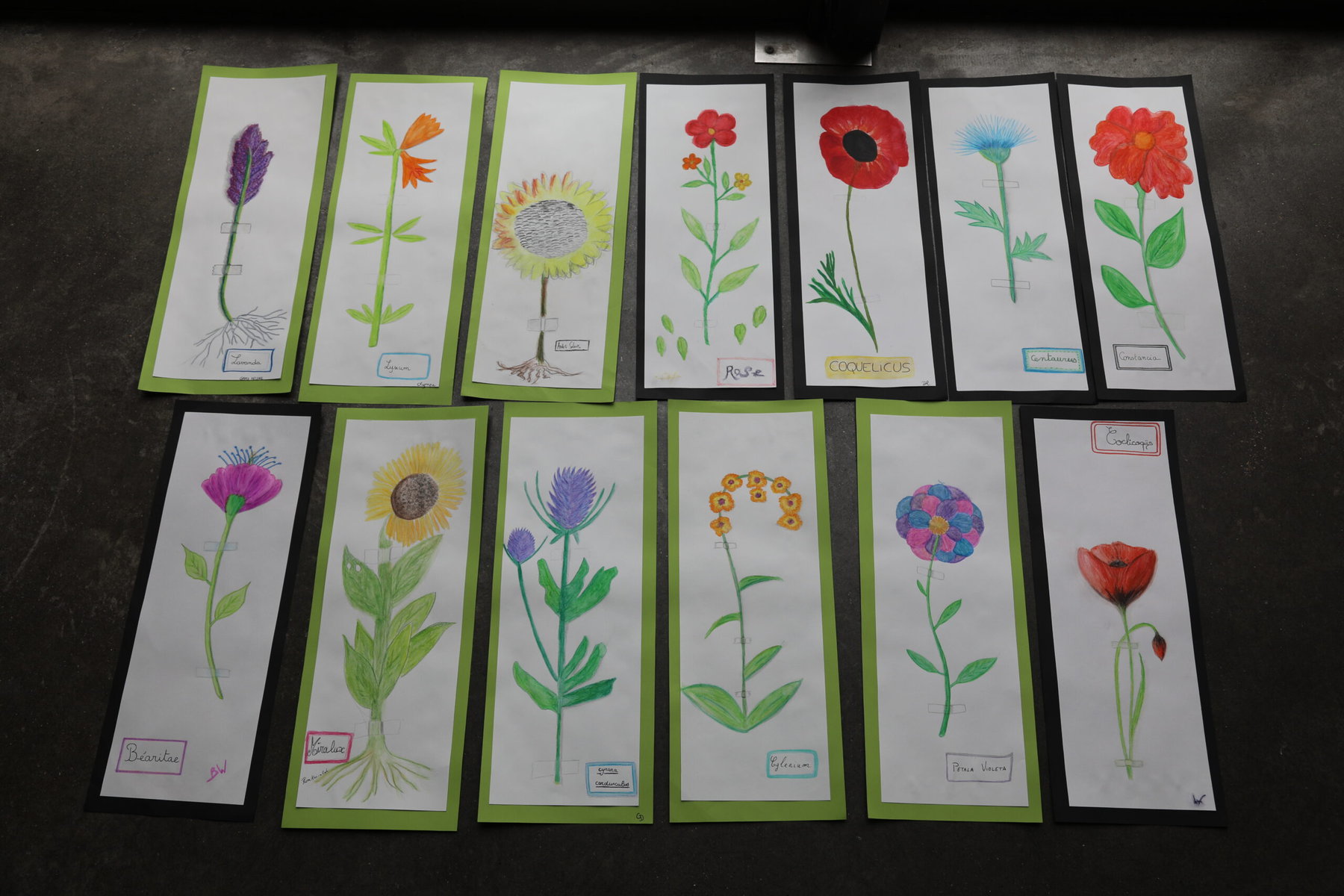“Yes yes yes, that’s extraordinary,” exclaims Pascaline Bonnave, hopping around with glee after briefly studying a scarlet, poppy-esque drawing with her judicious eyes. “That’s really beautiful. Now you must give a name to it.”
Bonnave, dressed in blue jeans and a leather jacket covered in patches of flowers and birds, swivels to look at the progress of the other participants in her art therapy class.
The task for the dozen attendees today is to invent their own flower as well as to coin a plausible species name. There are tall, yellow florets heavily inspired by sunflowers; exquisite purple, mauve and pink posies; and winding chains of daisy-like blossoms.
“It’s not that it’s not beautiful,” adds Bonnave, encouraging one woman who doubts her floral creation. “You just need to finish it. Add some shading. Give it some roots.”
The afternoon’s activity, simple as it may seem, is part of a unique initiative drawing on the genuine power of art and culture to improve people’s health and wellbeing.
For more than a decade, the French city of Lille’s Palais des Beaux-Arts — which was inaugurated in 1892 and is home to France’s second largest collection behind only the Louvre — has deployed a kind of “museo-therapy” that uses the museum space and the treasures held within it to help treat patients from local hospitals.
But in September 2023, this initiative became a little more formal when it signed an agreement with the University Hospital Center of Lille (CHU) to offer 140 museum art therapy sessions over a year to patients who have been given a “museum prescription” by doctors, making it one of the most significant programs of its kind in the world.
The idea of a museum prescription, which fits under an umbrella of out-of-hospital, nonclinical treatment known as social prescribing, is that exposure to art and culture or history can complement, accelerate or potentially even displace some forms of medical care in traditional settings — in an effective, enjoyable and low-cost manner.

Lille’s Palais des Beaux-Arts has been working with all kinds of participants, such as people with Alzheimer’s, drug users and autistic children. Once a week, there’s also an open class for the general public. This day’s session is for women receiving treatment for endometriosis, medically assisted reproduction and gynecological or breast cancer.
Bonnave begins each two-hour session with a brief tour of the museum’s collection to inspire participants. For this class, she picked a few Realist paintings of flowers and fruits, otherwise known as nature morte, in the museum’s Dutch section.
“I know the power of art,” says Bonnave. “This place is a gold mine of inspiration.”
Then, participants move to another part of the museum to do an art therapy session.
The efforts, which began a decade ago with sessions for autistic children, were in part triggered by the museum’s need to involve the public in the arts as part of a French obligation for cultural institutions known as the PSC, according to Marie Vidal de la Blache, the Palais’s public development manager and lead for art-health projects.
“The role of museums isn’t just to present art works,” says De la Blache. “As a museum, we have to be a social actor. We can’t just serve the same people.”
The development of the program began with many meetings between city officials and museum figures as well as doctors and hospital representatives in Lille, and it took years to build the awareness, appreciation and demand for the approach.
“It took a while to spread,” adds De la Blache. But now sessions are fully booked.
Crushed by negative news?
Sign up for the Reasons to be Cheerful newsletter.
Lille’s museum prescriptions program held its first session in November and is around half way through its year-long course. Questionnaires are being given to participants before and after sessions, which will later be studied to assess the impact of the project.
Nonetheless, according to Julia Hotz, a journalist and author of The Connection Cure, a book exploring the impact of social prescribing projects in 30 countries across the world, there is already an “extremely wide” evidence base for the practice.
“There’s a lot of evidence to show that social prescribing improves health outcomes,” says Hotz. “And there is more and more every year.”

For example, a longitudinal study of 23,660 individuals in the UK participating in choirs, book clubs, amateur theater and other cultural groups between 2010 and 2015 found that people who were frequently engaged in arts “had lower levels of mental distress and higher levels of mental functioning and life satisfaction.”
Similarly, research spanning more than 90,000 elderly people over 16 countries in 2023 found those with hobbies had fewer depressive symptoms and higher levels of health and life satisfaction. A 25-year study of adults in Copenhagen found those involved in sports groups had life expectancies up to 10 years higher. Meanwhile, a study of 11,000 adolescents in the US found extracurricular arts activities reduced loneliness and boosted peer support, a lack of which can lead to antisocial or criminal behavior.
Hotz says there are a broad number of applications for social prescribing, such as treating diabetes and health issues, often with sports and physical activity-oriented clubs, as well as tackling loneliness, anxiety and attention disorders, with cultural initiatives like Lille’s museum prescriptions.
“Museums take us out of our own head,” she says. “We get lost in the beauty of something else. It removes us from our anxiety.”
That claim is hard to disagree with while within the airy surroundings of the Palais des Beaux-Arts, whose highlights include Édouard Manet’s intimate modernist portraits and Peter Paul Rubens’ grand 17th-century masterpieces.
For Bonnave, who has done hundreds of sessions in her career, the benefits are clear to see. “For some participants, you can see that entering the museum is a great honor for them,” she says. “Some begin quiet, but you see they change; grow in confidence.”
Participant Beatrice, 43, agreed that doing the activities within the museum took the experience to another level. “The space is really moving, the light is beautiful,” she says. “I completely lost my sense of time [during the session].”
She added that the museum prescriptions had helped her to deal with burnout. “Normally, I don’t do art at all, I’m not talented like that. But each time, I’ve been very proud of what I did.”
The relatively low cost of social prescriptions and the context of growing strains on health care services in the aftermath of the pandemic are further incentives for institutions to invest in them further, according to Hotz.

“It reduces the number of times people need to go to the doctor,” she says.
A report in 2018 by the Royal College of General Practitioners, a professional body for over 50,000 doctors in the UK, found that the majority of doctors said they see one to five patients per day who attended an appointment “mainly because they are lonely” — patients who Hotz says could be treated via social prescribing.
Lille’s program, which will involve an estimated 1,400 participants across the year, required funding of just €21,000 ($22,500 US) from City Hall — a drop in the ocean of the millions spent every year on healthcare in the city of 236,000 people.
However, the research is still lacking when it comes to quantifying the cost-benefit of social prescriptions, according to Helen Chatterjee, a professor at University College London, who led a team researching museum prescriptions between 2014 and 2017, specifically projects linking lonely older people with partner museums in the UK.
“There’s lots of good anecdotal evidence,” says Chatterjee. “But hardcore health-economics evidence is lacking.”
Yet the arrival of that proof is considered to be only a matter of time, and momentum is quickly growing behind community-led care. In France, the MO.CO. Contemporary Art Museum in Montpellier has an “Art by prescription” scheme, and since January, Lyon’s Claude Bernard University has offered the country’s first college degree in “Cultural Prescriptions,” in conjunction with neurologists, psychologists and arts professionals. Louvre-Lens also recently signed an agreement following in the footsteps of Lille, which will have its funding renewed for at least several years.
“We want to experiment with this approach further,” says Marie-Pierre Bresson, the deputy mayor of Lille responsible for culture, tourism and decentralized cooperation.
Further afield, the Montreal Museum of Fine Arts has worked with the Francophone Doctors of Canada association since 2018 to offer a form of museum prescriptions, albeit without Lille’s art therapy aspect. In Brussels, Belgium, doctors in one of the city’s largest hospitals have been prescribing museum visits to patients suffering from depression, stress and anxiety since 2022 — and this year that expanded to 18 “medical structures” and 13 museums in the city. Singapore has run an Arts for Healing Program connecting patients with offerings at local music schools and community gardens since 2021. The newly formed advocacy group Social Prescribing USA aims to make social prescribing available to every American by 2035, building on projects already running in Massachusetts and New Jersey.
The great challenge for now, however, is figuring out how to scale up social prescription programs that are inherently most effective when small-scale and highly contextual.
“The big Catch-22 is that these initiatives have to be so local and individualized,” says Hotz.
But Chatterjee, whose research has looked at how to formalize museum prescriptions, believes progress has been made in the UK, where there is greater recognition than almost anywhere else of the fact that many social factors determine an individual’s health.

“We are seeing a shift in how institutions are operating from short projects to longer-term core work,” she explains. “The most effective outcomes are achieved when projects are co-designed with participants and when they are sustained over longer, regular periods.”
Fittingly, Chatterjee is now leading a three-year, £25 million ($31 million US) project that began in February exploring “how health systems can collaborate more effectively with communities” to tackle health inequalities in poorer parts of the UK.
“There’s still very small amounts of money going to [social prescription] providers,” says Chatterjee. “We’re not throwing enough resources at prevention. But we know that when we do have these collaborations, they can be really fruitful. There’s nothing else like them.”
The post A Dose of Inspiration: Why Doctors Are Prescribing Museum Visits appeared first on Reasons to be Cheerful.




